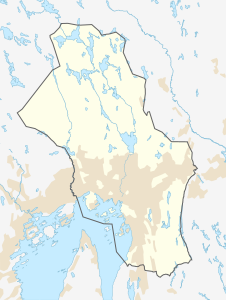Gressholmen
| Gressholmen | ||
|---|---|---|
| Waters | Oslofjord ( North Sea ) | |
| Geographical location | 59 ° 52 '56.9 " N , 10 ° 42' 59.2" E | |
|
|
||
| surface | 5 ha | |
Gressholmen ( German "small grass island" ) is a small island in the inner Oslofjord , not far from the city center of the Norwegian capital Oslo with an area of approx. 5 hectares . The island includes the small peninsulas Rambergøya and Heggholmen. It is connected to Oslo by a ferry . Large parts of the island are now a nature reserve , but there is also a larger marina and some residential and weekend houses.
history
Hunting and shooting range
Since the 17th century, the then largely uninhabited island served as a royal hunting ground . In 1864 the first publicly accessible shooting range in Oslo, then still Christiania , was opened in the southern part of the island . Here the citizens of the city could train with their own firearms. The plant was later expanded, but operations were temporarily suspended with the beginning of the Second World War. The facility was finally closed in the mid-1970s. Until spring 2007, the island was known for the large population of the mostly tame wild rabbits that lived there for many years . These were probably the offspring of rabbits released for hunting in the 19th century. However, since these caused increasing damage to the flora and fauna of the nature reserve, it was decided to drastically reduce the population in spring 2007.

Water airport
On the island, the first was in 1927-1939 airfield for seaplanes Oslo until he built from new and in 1939 opened Oslo Airport, Fornebu was replaced. During the Second World War and the German occupation of Norway, a shipyard for German seaplanes was set up by the occupiers on the island; for defense, a small position with a sea / land target gun was set up above the jetty. All military installations have meanwhile been removed, but the old concreted jetty as well as the handling and workshop buildings have been preserved. The former hangar, which was connected to the pier by a drainage and transport track, still exists today and is used as a boat hall for the local yacht club. The concrete foundation of the former gun emplacement is still preserved.
Commercial establishments
Despite its small size of less than five hectares, two businesses had settled here, which existed until the middle of the 20th century. Due to local complaints about air pollution, a soap factory moved from the densely built-up city center of Oslo to the island in the middle of the 19th century . In addition to the factory hall, further residential and administrative buildings were built. When operations ceased in 1965, the factory premises initially fell into disrepair until parts of the existing buildings were converted into holiday apartments and could thus be preserved.
In addition, there was a company for the production of lacquers and paints on Gressholmen since around 1900. A 400-meter-long narrow-gauge railway with its own turntable was specially built to transport material between the pier and the factory premises . Although the facility was abandoned at the beginning of the Second World War, remnants of the small railway line including the turntable can still be found on the island today.
Recreation area
Since the 1960s, the island has served almost exclusively as a recreational area for the residents of Oslo. Large parts of the island were placed under nature protection as a "nature reserve" in 1992 and there are several bathing areas and sunbathing areas on the island. Holiday apartments were built in a former factory workers' house of the soap factory and the Gressholmen Kro inn is open during the summer months . All motorized traffic is prohibited on the island.
